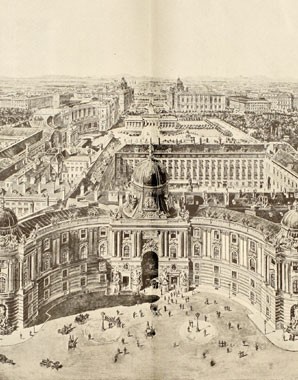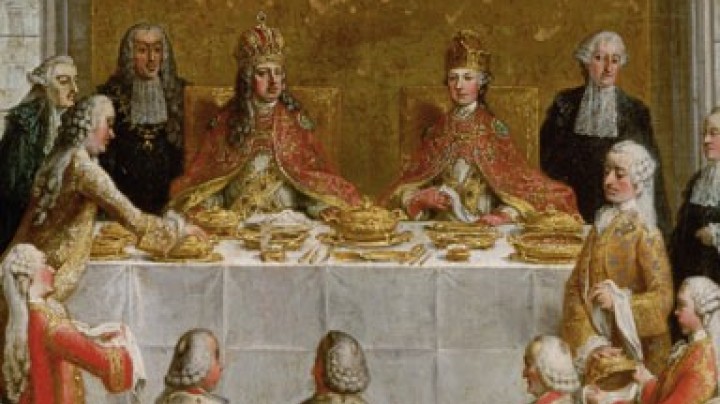A question of priorities
Traditionally it was for its status as the seat of empire rather than the magnificence of its architecture that the imperial Court at Vienna was famed – whether this was due to a lack of money, as malicious tongues suggested, or the result of piety towards the divinely sanctified office of the emperor coupled with a sense of veneration for the tradition that the Hofburg complex represented.
Quoted from: Unterreiner, Katrin, ‘Baugeschichte der Hofburg – Von der Mitte des 16. Jahrhunderts zum Ende der Monarchie’, in: Die Wiener Hofburg – Lernbehelf für Guides, Vienna 2005, 46In 1649 the topographer Matthäus Merian described the imperial palace as ‘not particularly magnificently built and rather cramped for such a mighty and sublime potentate’.
When Ferdinand I made Vienna his principal residence in 1533, it was the starting signal for the first alterations to the Gothic fabric of the Hofburg. One major alteration during this phase was the creation of the main portal into the inner courtyard of the old palace now known as the Schweizer Tor (Swiss Gate), one of the first Renaissance accents in the otherwise rather austere architecture of the Hofburg. But even this magnificent portal gave priority to the aspect of defence, as the palace continued to form an important part of the city’s fortifications.
Renaissance elements featured to a greater extent in the architecture of the Stallburg. Originally erected between 1559 and 1568 as a separate palace for the future emperor Maximilian II, its name derives from its use as stabling for the Lipizzan stallions. With its arcaded courtyard it remains an impressive edifice. A generation later another palace, which later came to be known as the Amalienburg, was built for Rudolf II.
While the scramble for supremacy between Vienna and Prague was as yet undecided in the sixteenth century, in 1612 Emperor Matthias moved the permanent residence of the Habsburgs to Vienna. However, this did not result in any appreciable increase in building activity. Lack of money due to continual warfare meant that the range known as the Leopoldinischer Trakt after the monarch who commissioned it, remained the only large project realised during the seventeenth century.
In the seventeenth century the Habsburgs generally showed little interest in large architectural projects. Numerous contemporary descriptions referred to the Hofburg as being a residence inappropriate to the standing of an imperial power. Even as late as 1700 the Viennese Court had still not altered in this regard, a somewhat surprising circumstance given the contemporary political successes and the widespread construction boom Vienna was experiencing at the time.
Under Emperor Charles VI, when the need to modernize had become imperative, a number of additions were made to the Hofburg complex.
This era also saw the first projects that envisaged the radical rebuilding or complete replacement of the imperial residence. However, all these grandiose designs by some of the great architectural names of the time, such as Fischer von Erlach, Hildebrandt or Neumann, were destined to remain on the drawing-board.
It was not until Maria Theresa’s extensive rebuilding of Schönbrunn that the Habsburg court had for the first time a ‘modern’ stage on which to present itself in an appropriate manner.


















